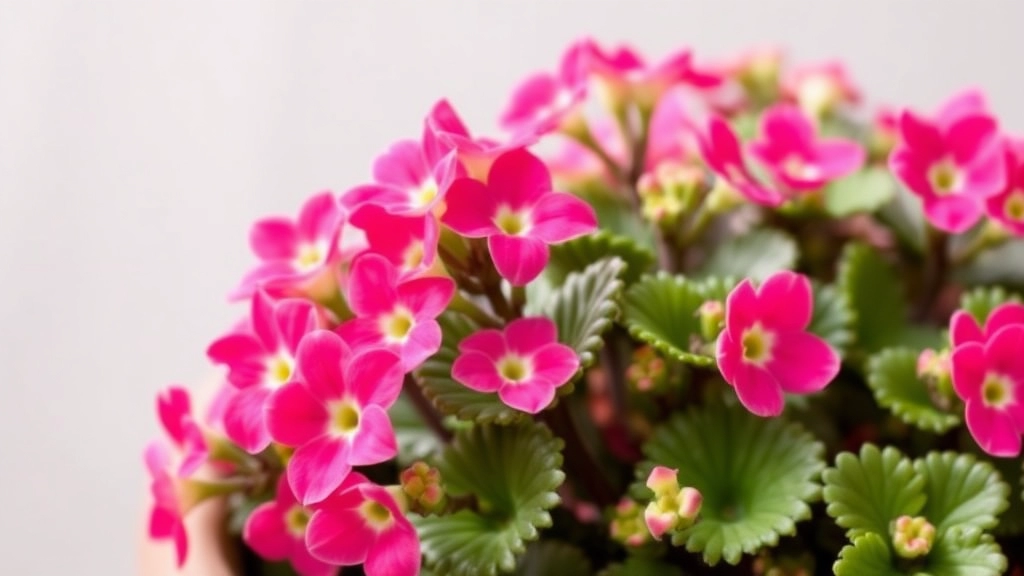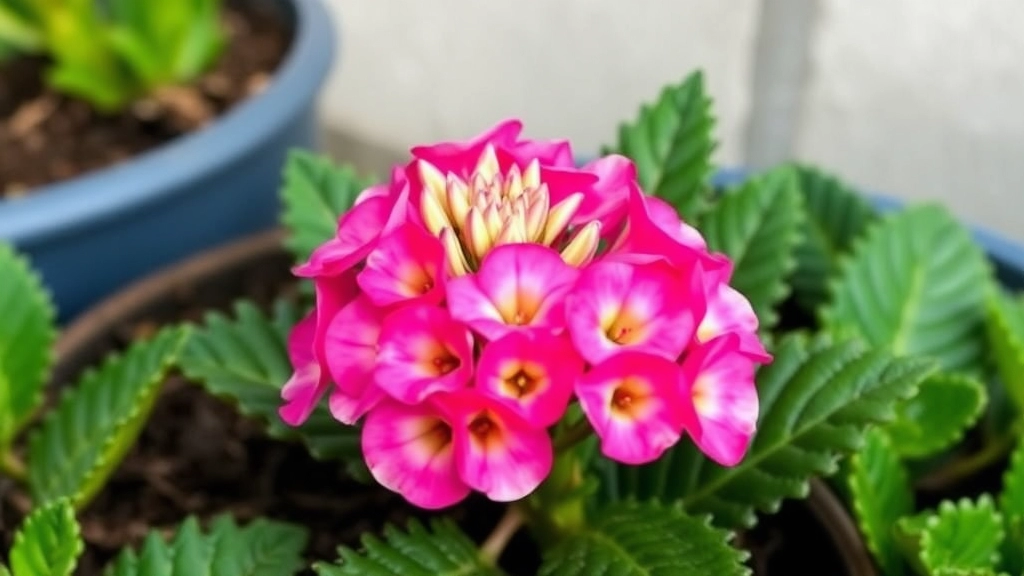Ever wondered, “How long does Kalanchoe live?”
You’re not alone. As a plant enthusiast, I’ve spent countless hours digging into the lifespan of this fascinating succulent. Typically, a Kalanchoe can thrive for several years with the right care, making it a favourite among indoor gardeners.
Understanding Its Needs
Understanding its needs is key. From proper sunlight to watering habits, each aspect plays a role in extending its life. So, if you’re keen on keeping your Kalanchoe around for the long haul, stick with me as we dive into the essentials of Kalanchoe care.
Lifespan of Kalanchoe Plants
When it comes to Kalanchoe plants, a common question arises: how long can these beautiful succulents really last?
Kalanchoes, known for their vibrant flowers and hardy nature, typically have a lifespan of three to five years. However, with the right care, some can thrive even longer, becoming a cherished part of your indoor garden.
Understanding the lifespan of Kalanchoe plants is essential for nurturing them effectively.
Lifespan Overview
- Average Lifespan: 3-5 years
- Potential Longevity: Up to 10 years with optimal care
While their lifespan may seem modest, the joy they bring during this time can be significant.
The lifespan of a Kalanchoe can be influenced by various factors, including the environment, care practices, and specific species. For more detailed care tips, check out our complete guide to caring for Kalanchoe Mother of Millions. Additionally, understanding why your Kalanchoe isn’t flowering can also help in extending its lifespan.
Factors Influencing Kalanchoe Longevity

Ever wondered why some Kalanchoe plants thrive while others seem to fade away?
There are several factors that can significantly impact the lifespan of your beloved Kalanchoe.
1. Light Conditions
Kalanchoe plants love bright, indirect sunlight.
- Too little light can cause leggy growth and fewer blooms.
- Direct sunlight can scorch the leaves.
Finding that sweet spot is key to keeping your plant happy.
2. Watering Habits
Overwatering is one of the biggest culprits for plant decline.
- Check the soil: If it’s soggy, hold off on watering.
- Let it dry out: Kalanchoe prefers to be on the drier side.
A good rule of thumb is to water when the top inch of soil is dry.
3. Soil Quality
The right soil can make a world of difference.
- Well-draining potting mix is essential.
- Consider a cactus or succulent mix for optimal drainage.
This helps prevent root rot, which can be a real killer for Kalanchoe.
4. Temperature and Humidity
Kalanchoe thrives in warmer conditions.
- Ideal range: 20-25°C (68-77°F).
- Avoid cold drafts and sudden temperature changes.
They’re not fans of humidity, so keep them in a drier environment.
5. Fertilisation
Feeding your Kalanchoe can boost its longevity.
- Use a balanced fertiliser during the growing season.
- Dilute it to half strength to avoid overloading.
A little extra nutrition can go a long way in promoting healthy growth.
Care Tips for Extending Kalanchoe Life
As we explore ways to enhance the longevity of Kalanchoe plants, it’s essential to focus on practical care tips that can make a significant difference.
1. Ideal Lighting Conditions
Kalanchoe thrives in bright, indirect sunlight.
- Placement: Position your plant near a window where it can receive ample light without being scorched.
- Duration: Aim for about 6 hours of light daily.
2. Watering Wisely
Overwatering is a common pitfall.
- Frequency: Water only when the top inch of soil feels dry.
- Method: Ensure excess water drains out to prevent root rot.
3. Soil Selection
Choosing the right soil promotes healthy growth.
- Type: Use a well-draining cactus or succulent mix.
- pH Level: Aim for a slightly acidic to neutral pH (6.0 to 7.0).
4. Fertilisation
Feed your Kalanchoe to encourage blooming.
- Frequency: Fertilise every 4-6 weeks during the growing season (spring and summer).
- Type: Use a balanced, water-soluble fertiliser diluted to half strength.
5. Pruning and Deadheading
Regular maintenance keeps your plant vibrant.
- When: Prune after blooming to encourage new growth.
- Method: Remove dead flowers and any leggy stems to promote a bushier appearance.
6. Temperature and Humidity
Kalanchoe prefers specific environmental conditions.
Common Issues and Solutions

Even with the best care, Kalanchoe plants can face a variety of challenges. Understanding these common issues can help you maintain a healthy and thriving plant.
1. Overwatering
Symptoms: Yellowing leaves, mushy stems, and wilting.
Solution:
- Allow the top inch of soil to dry out before watering again.
- Ensure your pot has drainage holes to prevent water accumulation.
- Consider using a well-draining soil mix.
2. Underwatering
Symptoms: Droopy leaves, dry soil, and leaf drop.
Solution:
- Water your Kalanchoe thoroughly when the soil feels dry.
- Aim for a consistent watering schedule, typically every 2-3 weeks during the growing season.
3. Pests
Symptoms: Sticky residue on leaves, visible insects, or webbing.
Solution:
- Inspect your plant regularly for pests like aphids or mealybugs.
- Use insecticidal soap or neem oil for treatment.
- Isolate affected plants to prevent spreading.
4. Insufficient Light
Symptoms: Leggy growth, pale leaves, and slow growth.
Solution:
- Place your Kalanchoe in a bright, indirect light location.
- Rotate the plant every few weeks to ensure even light exposure.
5. Leaf Drop
Symptoms: Leaves falling off, particularly at the bottom.
Solution:
- Check for environmental stressors like drafts or temperature changes.
- Ensure your plant isn’t too root-bound, which can affect its health.
Seasonal Care and Maintenance
As we transition through the seasons, the care requirements for Kalanchoe plants can shift significantly. Understanding these changes is essential for maintaining their health and longevity.
Spring Care
During spring, Kalanchoe plants emerge from their dormant phase. This is the perfect time to:
- Increase Watering: As temperatures rise, ensure the soil remains slightly moist but not soggy.
- Fertilize: Use a balanced liquid fertiliser every few weeks to promote growth.
- Repot if Necessary: If your plant has outgrown its pot, consider repotting into a slightly larger container.
Summer Care
Summer can be challenging with increased heat. To keep your Kalanchoe thriving:
- Provide Shade: Protect your plant from harsh afternoon sunlight to prevent leaf scorch.
- Monitor Water: Water more frequently, but ensure proper drainage to avoid root rot.
- Pest Checks: Keep an eye out for pests like aphids and mealybugs, which may thrive in warm weather.
Autumn Care
As temperatures begin to drop in autumn, adjust your care routine:
- Reduce Watering: Allow the soil to dry out more between waterings.
- Limit Fertiliser: Cut back on fertiliser as the plant prepares for dormancy.
- Inspect for Health: Check for any signs of stress or disease as the plant transitions.
Winter Care
Winter is a critical time for Kalanchoe plants, as they enter dormancy:
- Lower Light Levels: Keep your plant in a bright location, but avoid direct sunlight.
- Water Sparingly: Water only when the soil is completely dry to prevent overwatering.
- Temperature Control: Ensure your plant is kept in a warm environment, ideally above 10°C. For more detailed information, refer to the Kalanchoe Temperature Tolerance Guide.
For more specific care tips, you can also check out our Expert Tips on Kalanchoe Care.
FAQs on Kalanchoe Longevity
How long does a Kalanchoe plant typically live?
A Kalanchoe plant can live for several years with proper care. On average, they can thrive for 3 to 5 years, but some can live even longer under optimal conditions.
What are the best light conditions for Kalanchoe?
Kalanchoe plants thrive in bright, indirect sunlight. Too little light can cause leggy growth and fewer blooms, while direct sunlight can scorch the leaves. Finding the right balance is crucial for their longevity.
How often should I water my Kalanchoe?
Water your Kalanchoe when the top inch of soil is dry. Overwatering can lead to root rot, so it’s better to err on the side of underwatering. Aim for a consistent schedule, typically every 2-3 weeks during the growing season.
What type of soil is best for Kalanchoe?
A well-draining potting mix is essential for Kalanchoe. Consider using a cactus or succulent mix to ensure optimal drainage and prevent root rot.
What temperature range is ideal for Kalanchoe?
Kalanchoe thrives in warmer conditions, ideally between 20-25°C (68-77°F). Avoid cold drafts and sudden temperature changes to keep your plant healthy.
How often should I fertilize my Kalanchoe?
Fertilize your Kalanchoe during the growing season with a balanced fertilizer diluted to half strength. This can boost its longevity and promote healthy growth.
What are common issues with Kalanchoe and how can I solve them?
Common issues include overwatering, underwatering, pests, insufficient light, and leaf drop. Address these problems by adjusting your care routine, such as ensuring proper watering, providing adequate light, and inspecting for pests regularly.
What should I do if my Kalanchoe is dropping leaves?
Leaf drop can be caused by environmental stressors like drafts or temperature changes. Ensure your plant isn’t too root-bound and check for any other stress factors that might be affecting its health.
How can I prevent pests on my Kalanchoe?
Inspect your plant regularly for pests like aphids or mealybugs. Use insecticidal soap or neem oil for treatment and isolate affected plants to prevent spreading.
Can Kalanchoe survive in high humidity environments?
Kalanchoe prefers a drier environment and does not thrive in high humidity. Keep them in a location with good air circulation and avoid overly humid conditions.
References
-
Kalanchoe Plant Care: How To Grow A Kalanchoe
-
How to Grow Kalanchoe Plants Indoors
-
Kalanchoe: Plant Care & Growing Guide
